vector container
concept
- Very similar to arrays
- vector can be extended dynamically, but array cannot
- Points to a contiguous piece of memory
- Dynamic expansion is to find a new and larger space to store data, rather than adding a new space behind it
Iterator failure: when the vector finds a new and larger space, the previous iterator fails
structure
| method | effect |
|---|---|
| vector v; | Using template implementation class implementation, default constructor |
| vector(v.begin() , v.end()) | Copy the elements in the v[begin(),end()) interval to itself (note that the front is closed and the back is open) |
| vector(n, elem) | The constructor copies n elem s to itself |
| vector(const vector &vec) | copy construction |
assignment
It is relatively simple. Generally, both operator = and assign can be used
| method | effect |
|---|---|
| vector& operator=(const vector &vec) | Overloaded equal sign operator |
| assign(beg,end); | Assign the data copy in the [beg,end] interval to itself |
| assign(n,elem) | Copy n elem s to itself |
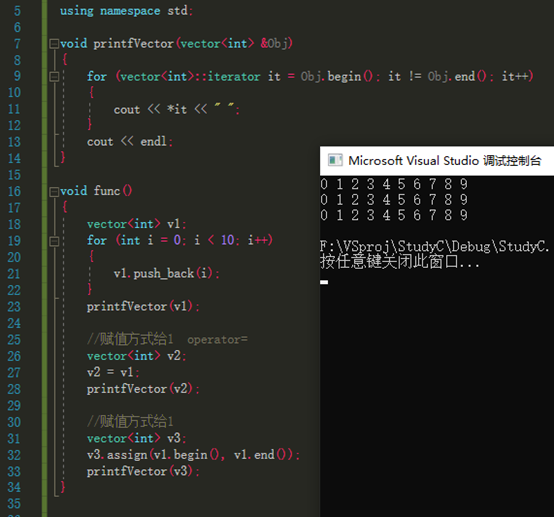
void printfVector(vector<int> &Obj)
{
for (vector<int>::iterator it = Obj.begin(); it != Obj.end(); it++)
{
cout << *it << " ";
}
cout << endl;
}
void func()
{
vector<int> v1;
for (int i = 0; i < 10; i++)
{
v1.push_back(i);
}
printfVector(v1);
//Assignment method to 1 operator=
vector<int> v2;
v2 = v1;
printfVector(v2);
//assign assigns the data copy in the [beg,end] interval to itself
vector<int> v3;
v3.assign(v1.begin(), v1.end());
printfVector(v3);
//assign(n, elem) Copy n elems to itself
vector<int> v4;
v4.assign(5,10);
printfVector(v4);
}
Capacity and size
| method | effect |
|---|---|
| empty(); | Determine whether the container is empty |
| capacity(); | Capacity of container |
| size(); | Returns the number of elements in the container |
| resize(int num); | Reassign the length of the container to num. if it becomes longer, the new position will be filled with the default value. If it becomes shorter, the part beyond the container will be deleted |
| resize(int num ,elem) | Reassign the length of the container to num. if it becomes longer, fill the new position with elem. If it becomes shorter, the part beyond the container will be deleted |
Note: resize changes size, not capacity
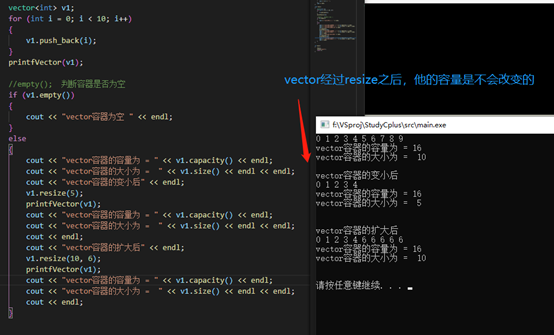
void printfVector(vector<int> &Obj)
{
for (vector<int>::iterator it = Obj.begin(); it != Obj.end(); it++)
{
cout << *it << " ";
}
cout << endl;
}
void func()
{
vector<int> v1;
for (int i = 0; i < 10; i++)
{
v1.push_back(i);
}
printfVector(v1);
//empty(); Determine whether the container is empty
if (v1.empty())
{
cout << "vector Container is empty " << endl;
}
else
{
cout << "vector The capacity of the container is = " << v1.capacity() << endl;
cout << "vector The size of the container is = " << v1.size() << endl << endl;
cout << "vector Smaller container" << endl;
v1.resize(5);
printfVector(v1);
cout << endl;
cout << "vector After expansion of the container" << endl;
v1.resize(10, 6);
printfVector(v1);
cout << endl;
}
}
Insert and delete
| method | effect |
|---|---|
| push_back(elem); | Tail insert element |
| pop_back(); | Delete last element |
| insert(const_iterator pos,elem) | The iterator inserts the element element element at the point |
| insert(const_iterator pos, int Count, elem) | The iterator points to the position pos and inserts count elements elem |
| erase(const_iterator pos); | Delete the element pointed to by the iterator |
| erase(const_iterator start, const_iterator end) | Delete the elements of the iterator from start to end |
| clear(); | Delete all elements in the container |
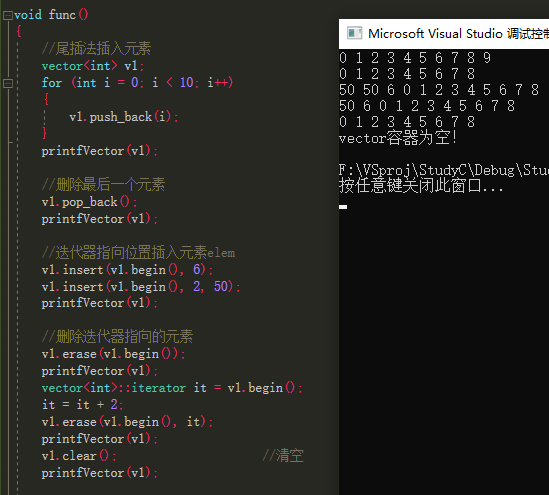
void printfVector(vector<int> &Obj)
{
if (Obj.size() == 0)
{
cout << "vector The container is empty!";
}
for (vector<int>::iterator it = Obj.begin(); it != Obj.end(); it++)
{
cout << *it << " ";
}
cout << endl;
}
void func()
{
//Insert elements by tail interpolation
vector<int> v1;
for (int i = 0; i < 10; i++)
{
v1.push_back(i);
}
printfVector(v1);
//Delete last element
v1.pop_back();
printfVector(v1);
//The iterator inserts the element element element at the point
v1.insert(v1.begin(), 6);
v1.insert(v1.begin(), 2, 50);
printfVector(v1);
//Delete the element pointed to by the iterator
v1.erase(v1.begin());
printfVector(v1);
vector<int>::iterator it = v1.begin();
it = it + 2;
v1.erase(v1.begin(), it);
printfVector(v1);
v1.clear(); //empty
printfVector(v1);
}
data access
| method | effect |
|---|---|
| at(int idx); | Returns the data indicated by the index idx |
| operator[]; | Returns the data indicated by the index idx |
| front(); | Returns the first data element in the container |
| back() | Returns the last array element in the container |
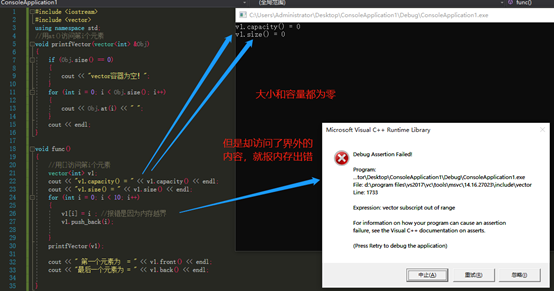
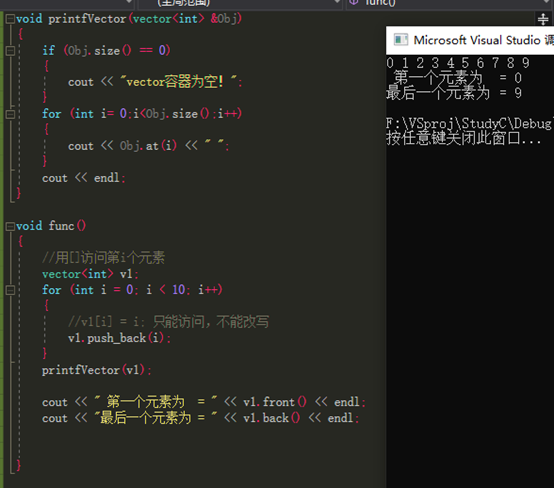
//Access the ith element with at()
void printfVector(vector<int> &Obj)
{
if (Obj.size() == 0)
{
cout << "vector The container is empty!";
}
for (int i= 0;i<Obj.size();i++)
{
cout << Obj.at(i) << " ";
}
cout << endl;
}
void func()
{
//Access the ith element with []
vector<int> v1;
for (int i = 0; i < 10; i++)
{
//v1[i] = i; Before that, because the capacity and size are 0, the statement belongs to cross-border access!
v1.push_back(i);
}
printfVector(v1);
cout << " The first element is = " << v1.front() << endl;
cout << "The last element is = " << v1.back() << endl;
}
Interchangeable container
| method | effect |
|---|---|
| swap(vec) | Swap vec with its own elements |
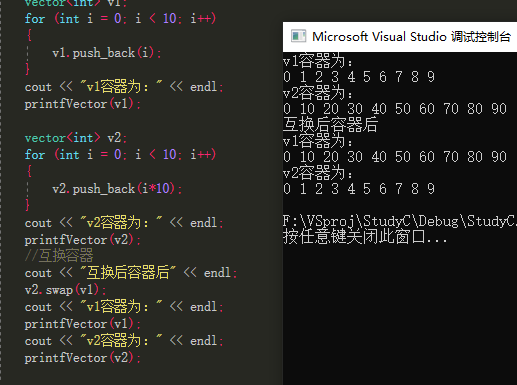
vector<int> v1;
for (int i = 0; i < 10; i++)
{
v1.push_back(i);
}
cout << "v1 The container is:" << endl;
printfVector(v1);
vector<int> v2;
for (int i = 0; i < 10; i++)
{
v2.push_back(i*10);
}
cout << "v2 The container is:" << endl;
printfVector(v2);
//Interchangeable container
cout << "After container exchange" << endl;
v2.swap(v1);
cout << "v1 The container is:" << endl;
printfVector(v1);
cout << "v2 The container is:" << endl;
printfVector(v2);
According to the characteristics of vector, the capacity of the container is > = the size of the container. If a container turns out to be very large, but the size is changed but the capacity is not changed after resizing, you can use the swap method to reduce the capacity
Principle: vector < int > (V1) swap(v1)
It can be decomposed into: vector < int > (V1) and swap(v1) two parts
Vector < int > (v1): indicates the creation of anonymous objects (for copy construction with v1)
. swap(v1): indicates that anonymous objects are exchanged with v1 to reduce the capacity of the container
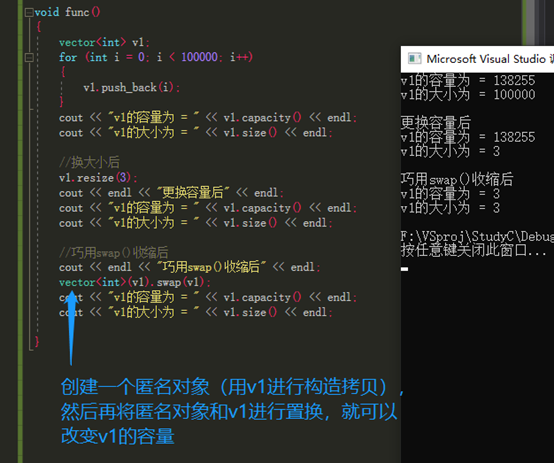
Reserved space
Main function: reduce the number of vector development during dynamic capacity expansion
| method | effect |
|---|---|
| reserve(int len) | The container reserves len element lengths, the reserved positions are not initialized, and the elements are inaccessible (change the capacity) |
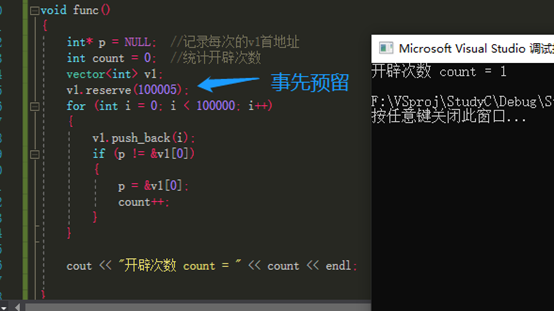
int* p = NULL; //Record the v1 first address each time
int count = 0; //Statistics of development times
vector<int> v1;
//If such a large space is known, it can be reserved first to avoid multiple development of Vector
v1.reserve(100005);
for (int i = 0; i < 100000; i++)
{
v1.push_back(i);
if (p != &v1[0])
{
p = &v1[0];
count++;
}
}
cout << "Development times count = " << count << endl;